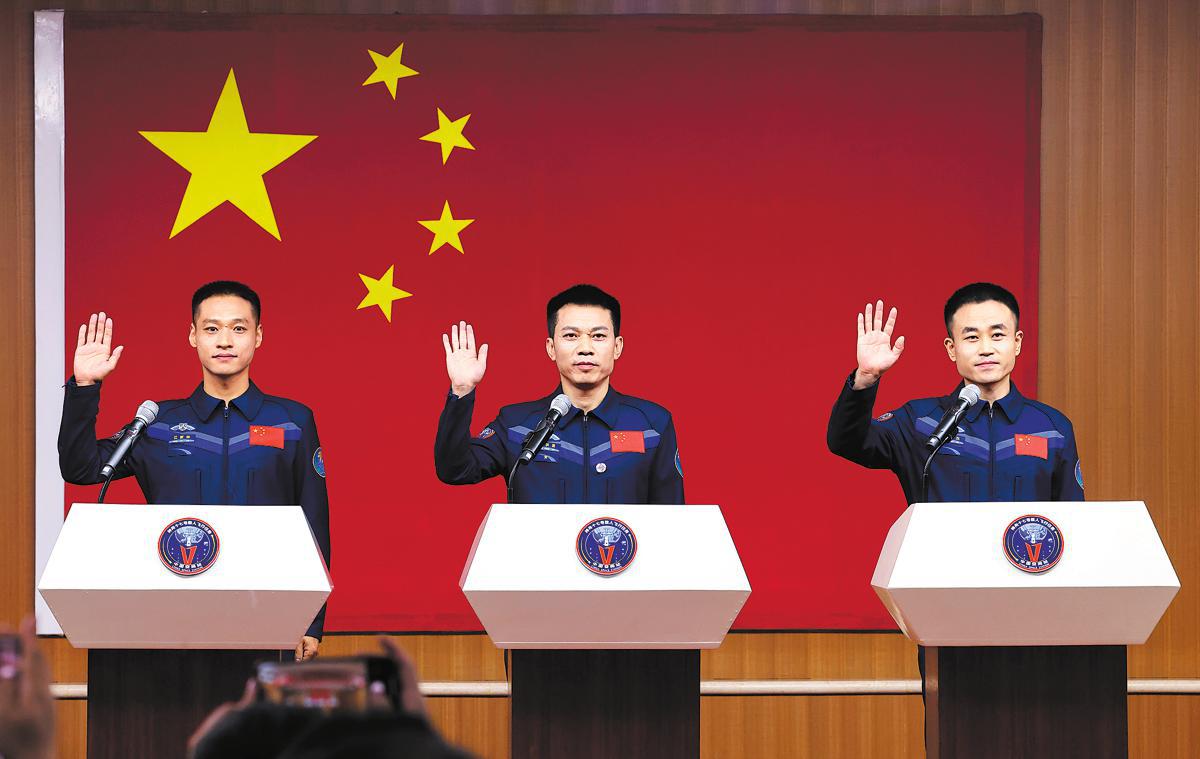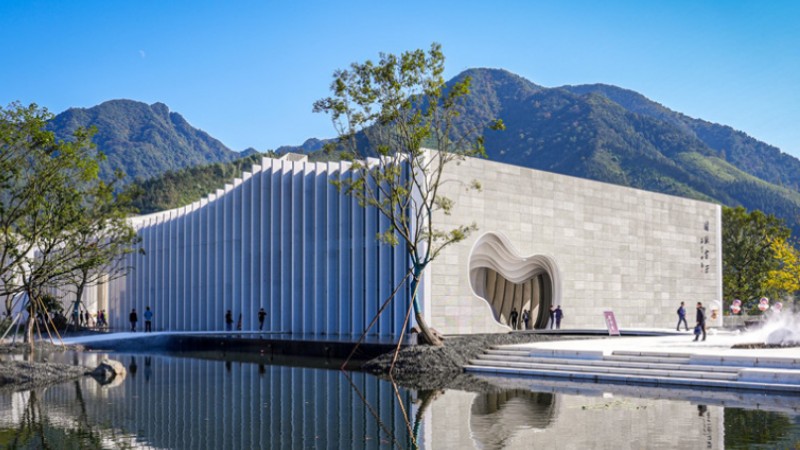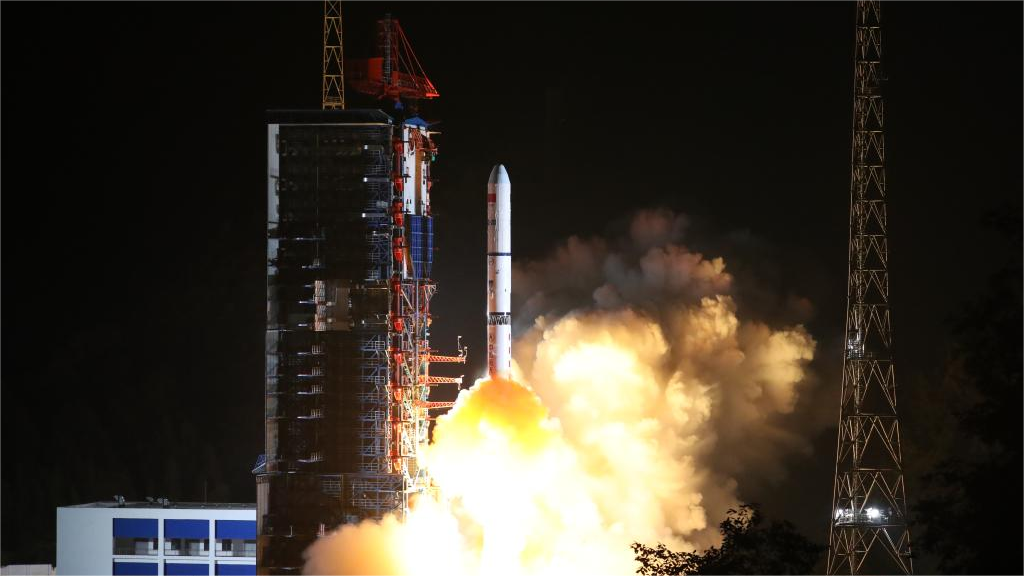12th crewed mission to focus on space debris

Crew members of Shenzhou XVII — mission commander Senior Colonel Tang Hongbo (center), Lieutenant Colonel Jiang Xinlin (left) and Lieutenant Colonel Tang Shengjie — meet with the media at Jiuquan Satellite Launch Center on Wednesday. [Photo by Zhu Xingxin / China Daily]
Mission:Country upholds peaceful use of outer space
China will launch its 12th manned spaceflight, the Shenzhou XVII, on Thursday morning to transport a three-member crew to the Tiangong space station, according to the China Manned Space Agency.
The spacecraft — with mission commander Senior Colonel Tang Hongbo, Lieutenant Colonel Tang Shengjie and Lieutenant Colonel Jiang Xinlin on board — is scheduled to be lifted by a Long March 2F carrier rocket at 11:14 am from the Jiuquan Satellite Launch Center in northwestern China's Gobi Desert, said Lin Xi-qiang, deputy director of the space agency, at a news conference on Wednesday.
"After the spacecraft enters its preset orbital position, it will activate the rapid rendezvous-docking mode and take about six and a half hours to approach and connect with the front port of the Tianhe core module," Lin said.
The Tiangong space station, orbiting about 400 kilometers above Earth, has three major components — the Tianhe core module and the Wentian and Mengtian science lab modules. It is currently connected with visiting Shenzhou XVI crew ship and the Tianzhou 6 cargo ship, and is one of the largest and most sophisticated space stations ever placed in orbit.
The Shenzhou XVII team will take over Tiangong from the Shen-zhou XVI crew, comprising mission commander Major General Jing Haipeng, Colonel Zhu Yangzhu and Professor Gui Haichao, who arrived at the space station on May 30. The two teams will be stationed together for about four days for handover work, after which the Shenzhou XVI crew will fly back to Earth.
The Shenzhou XVII astronauts are scheduled to stay inside Tiangong for around six months and return to Earth around April. Their tasks will include carrying out scientific experiments and technological demonstrations, conducting spacewalks to install equipment and maintain the massive orbital outpost, checking the space station's operational performance and obtaining relevant data, and helping to review the support capabilities of ground facilities, Lin said.
In addition to these routine tasks, there will be a new assignment for the Shenzhou XVII crew members — they will perform experimental repairing operations during spacewalks, the official said.
"As the amount of space debris keeps rising, it is inevitable for any long-working space station to be hit by small or micro debris. We have found that the solar arrays on Tiangong have been slightly damaged by debris," he said.
Lin said that such scenario was taken into account when plans for the Tiangong project were made, and the space station is still in good condition.
"However, to ensure Tiangong's long-term operation and to verify our technical capabilities, we have arranged the Shenzhou XVII crew to make experimental repairing operations during their extravehicular activities, which will be very challenging," he added.
If such experimental maneuvers are successful, they will mark a significant advance in China's capability to make and support spacewalk, Lin said.
Tang, the Shenzhou XVII mission commander, is one of the nation's second-generation astronauts. He is set to become the first Chinese astronaut making two spaceflights within the shortest interval. Tang's first space journey was on the three-month-long Shenzhou XII mission, which concluded two years and one month ago. He will also be the first astronaut to return to Tiangong.
Tang Shengjie and Jiang are from China's third generation of astronauts and the Shenzhou XVII mission will be their first journey to the Earth's orbit. With an average age of 38, the three-member team will be the youngest Chinese crew in space.
Speaking about the next steps in the Tiangong program, Lin said that China will deploy a large space telescope in the near future to fly alongside the space station, and it also plans to launch more science modules to connect with the station.
China is open to international cooperation and communication in regard with the space station, ranging from joint flights to payload development, Lin said.
"We would like to invite all countries and regions dedicated to the peaceful use of outer space to work with us in the Tiangong program," he said, adding that China will also invite foreign astronauts to take part in its manned lunar expeditions.
The country's manned space program has always been of a peaceful nature and China has never sought "space hegemony", according to Lin.
He said the country's manned space program is an important part of mankind's exploration and use of outer space, and is totally intended for peaceful purposes.
"Our projects are meant to enrich human knowledge about the universe, expand the range of human presence and activities, and push forward the sustainable development of civilizations," he said.
Lin made the remarks when responding to a question on China's plans as the United States-led International Space Station is expected to retire around 2030.
Since the Chinese program's establishment in 1992, it has grown based on predetermined strategies and plans, and has gradually led to the completion of the Tiangong space station, the official said.
"Over this course, we have never pursued 'space hegemony' and have rather consistently upheld the peaceful use of outer space," Lin said.
When China's first astronaut Yang Liwei reached orbit, he greeted people around the world and wrote in his work log that "the Chinese people have now entered outer space for the peace and advancement of mankind", Lin said. "Yang also held a United Nations flag, making China the first country to carry a UN flag in its first manned mission," he added.
Photos
Related Stories
- Scientists call for deeper international space science cooperation
- China, S. Africa space ties promise wide scope
- China to livestream 4th class from space station
- 10 paintings from Africa on display at Tiangong
- Cargo spacecraft burns up as planned on Earth reentry
- Shenzhou XVI crew completes 1st spacewalk
- China aims to make manned moon landing before 2030
- Shenzhou XVI crew looks forward to challenge
- China's next manned space mission to begin soon
- China successfully launches flagship cargo mission supporting China Space Station's new operation phase
Copyright © 2023 People's Daily Online. All Rights Reserved.









